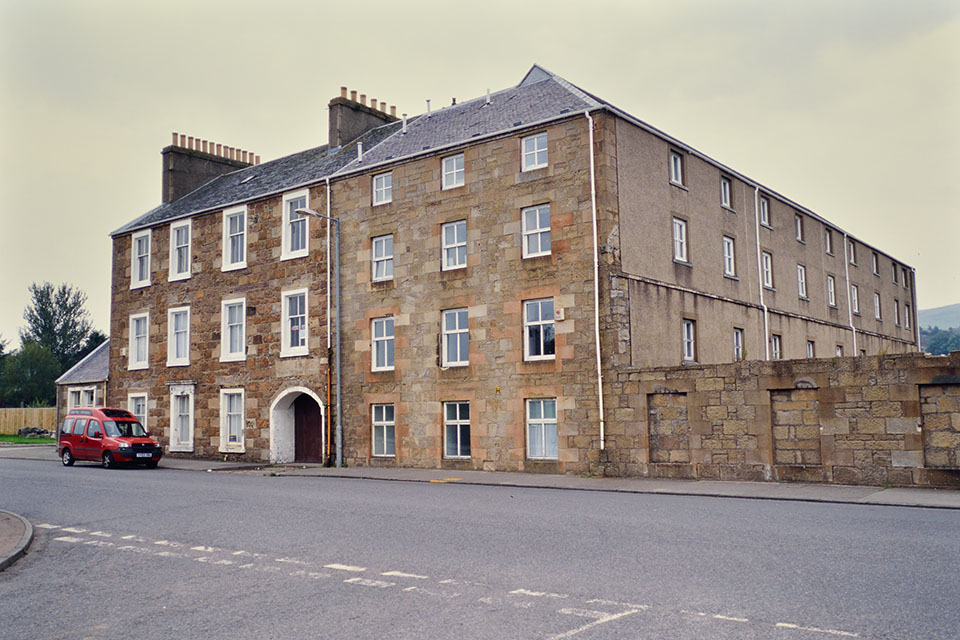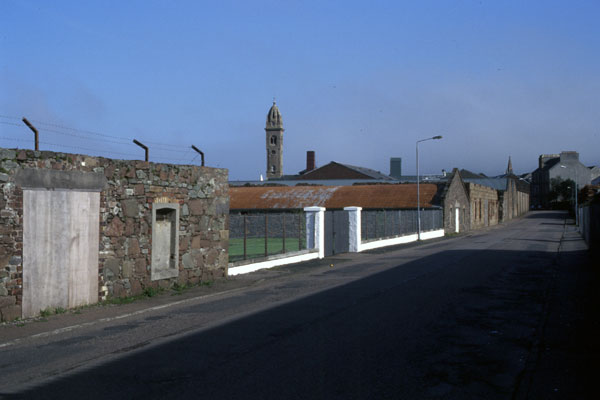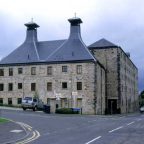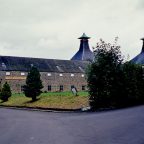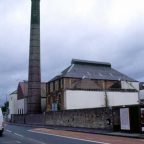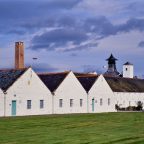Hazelburn Distillery(14 Sep 2008)
“マッサン”こと竹鶴政孝氏が修行していたHazelburn蒸留所。
創業は1825年で一時期はCampbeltownで最も大きな蒸留所でもあったけど、第一次世界大戦後のウィスキー不況で1920年にオーナーが変わり、1925年に閉鎖された。
ポットスティルは3基で、うち2基がネックの部分に水を通して冷却できる特殊な構造となっていたと記録されている。
現在は一部の建物が残り、会社の事務所として使用されている。
マッサンが帰国したのは1920年、Hazelburn蒸留所のオーナーが変わったのも同じ頃。衰退していくCampbeltownのウィスキー産業を目の当たりにしてどう思っていたのだろう。1920年代に次々に閉鎖されていく蒸留所の行く末を予想していたのだろうか。
創業は1825年で一時期はCampbeltownで最も大きな蒸留所でもあったけど、第一次世界大戦後のウィスキー不況で1920年にオーナーが変わり、1925年に閉鎖された。
ポットスティルは3基で、うち2基がネックの部分に水を通して冷却できる特殊な構造となっていたと記録されている。
現在は一部の建物が残り、会社の事務所として使用されている。
マッサンが帰国したのは1920年、Hazelburn蒸留所のオーナーが変わったのも同じ頃。衰退していくCampbeltownのウィスキー産業を目の当たりにしてどう思っていたのだろう。1920年代に次々に閉鎖されていく蒸留所の行く末を予想していたのだろうか。
Hazelburn Distillery, it is known as a distillery which The Great Father of Japanese Whisky, Mr. Masataka Taketsuru (nickname is Massan) had been training of making whisky.
Hazelburn Distillery was established in 1825. It became the largest whisky distillery in Campbeltown in the end of 19th century. But the owner changed in 1920 during depression of whisky industry after the WW1, and it was closed in 1925.
There were 3 pot stills, 2 of them were unique shape, According to the book of Alfred Barnard, it had been a special structure that can be cooled through the water in the neck of pot still.
Some of building remain in the town as a office building these days.
Massan returned to Japan in 1920, it was a same time to change a owner of Hazelburn Distillery first time. I don’t know that Massan thought about the declination of whisky industry of Campbeltown, he had expected the fate of the distillery, which will be closed one after another in the 1920s.
Hazelburn Distillery was established in 1825. It became the largest whisky distillery in Campbeltown in the end of 19th century. But the owner changed in 1920 during depression of whisky industry after the WW1, and it was closed in 1925.
There were 3 pot stills, 2 of them were unique shape, According to the book of Alfred Barnard, it had been a special structure that can be cooled through the water in the neck of pot still.
Some of building remain in the town as a office building these days.
Massan returned to Japan in 1920, it was a same time to change a owner of Hazelburn Distillery first time. I don’t know that Massan thought about the declination of whisky industry of Campbeltown, he had expected the fate of the distillery, which will be closed one after another in the 1920s.
Glebe Street(25 April 2004)
かつては20ヶ所以上あったCampbeltownの蒸留所も今では3蒸留所が操業しているだけとなっている。しかし今なお、町を歩けばウェアハウスにあたるといった感じで古い建物は何かしら蒸留所関連だったといってもいいだろう。特にメインストリートであるLongrowの西側にあるGlebe Streetは両側に5ヶ所も蒸留所があり、現存する倉庫らしき古い建物の木の扉には必ず”Duty Free Warehouse”の文字を見ることができる。
1920年にHazelburn蒸留所で修行をしていた竹鶴政孝氏もこの通りを歩いたに違いない。もしタイムマシンがあるならば、1920年のCampbeltownに行ってみたい。
(写真中央に見える塔はLongrow Church、その右側の赤い煙突はSpringbank Distillery)
1920年にHazelburn蒸留所で修行をしていた竹鶴政孝氏もこの通りを歩いたに違いない。もしタイムマシンがあるならば、1920年のCampbeltownに行ってみたい。
(写真中央に見える塔はLongrow Church、その右側の赤い煙突はSpringbank Distillery)
There were more than 20 distilleries in Campbeltown during the golden era, but it’s only 3 now.
However, some old buildings such as a storehouse would be remains of distilleries.
Especially there were 5 distilleries on Glebe Street, on the west side of Longrow. Now you can see a character of “Duty Free Warehouse” on the old door or sign at buildings on Glebe Street.
Mr. Masataka Taketsuru who had been training in Hazelburn distillery in 1920 must have walked down on Glebe Street. If there is a time machine, I want to go to Campbeltown in 1920.
However, some old buildings such as a storehouse would be remains of distilleries.
Especially there were 5 distilleries on Glebe Street, on the west side of Longrow. Now you can see a character of “Duty Free Warehouse” on the old door or sign at buildings on Glebe Street.
Mr. Masataka Taketsuru who had been training in Hazelburn distillery in 1920 must have walked down on Glebe Street. If there is a time machine, I want to go to Campbeltown in 1920.
